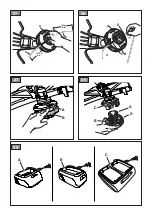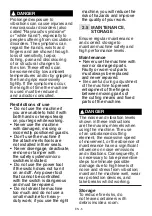
EN - 4
•
Remember that the operator
or user is responsible for
accidents and unexpected
events that can occur to other
people or property. It is the
user’s responsibility to assess
the potential risk of the area
where work is to be carried out
and to take all the necessary
precautions to ensure his
own safety and that of others,
particularly on slopes or rough,
slippery and unstable ground.
•
If the machine is sold or
lent to others, make sure
that the operator looks
over the user instructions
contained in this manual.
2.3 PRELIMINARY
OPERATIONS
Personal Protective
Equipment (PPE)
•
Always wear slim-fitting
protective clothes with
slash-proof protection, anti-
vibration gloves, helmet,
protective goggles, half-
mask respirator, protective
earplugs, cut resistant safety
boots with non–slip soles.
• Use of hearing protections can
reduce the ability to hear any
warnings (shouting or alarms).
Be careful of what occurs
around you in the work area.
•
Never wear scarves, shirts,
necklaces, bracelets, loose
flowing clothing, laces or ties
or any hanging or flapping
accessory that could catch in
the machine or in any objects
or materials in the work area.
•
Tie your hair back if it is long.
Work / Machine Area
•
Thoroughly inspect the
entire work area and remove
anything that could be thrown
by the machine or damage
the cutting means/rotating
units (stones, branches,
iron wire, bones, etc.)
.
2.4 DURING OPERATION
Work Area
•
Do not use the machine
in environments that pose
the risk of explosion, in the
presence of flammable liquids,
gases or powders. Power
tools create sparks which may
ignite the dust or fumes.
•
Work only in daylight or
with good artificial light in
good visibility conditions.
•
Keep people, children and
animals away from the work
area. Children must be
supervised by another adult.
•
Check that there is
nobody within 15 metres
of the machine’s range
of operation or within 30
metres for heavier cutting.
•
Avoid working with wet grass,
in the rain and when there
is a risk of a thunderstorm,
especially lightening.
•
Where possible, avoid working
on wet, slippery ground or
on uneven or steep ground
that does not guarantee
stability for the operator.
•
Do not expose the machine
to rain or wet environments.
Water entering a power
tool will increase the risk
of electric shock.
•
Pay careful attention to uneven
ground (hills, dips), slopes,
hidden hazards and obstacles
that could limit visibility.
•
Be very careful near ravines,
ditches or embankments.
Summary of Contents for BC 900 D Li 48
Page 5: ...1 XX XX XX XX XX C A C B 3 A B 4 5 6 A D C B 7 8 A C B B D C A ...
Page 6: ...1 XX XX XX XX XX 9 10 11 12 13 14 C D B B A B A C A B C A C B D E A ...
Page 7: ...1 XX XX XX XX XX 2 1 3 15 16 17 18 19 20 ...
Page 8: ...21 23 25 26 22 24 A B A B A B A ...
Page 9: ...A C D B 27 28 A B A B C D A B 150 mm 6 in 150 mm 6 in B A B C 29 28 27 ...
Page 44: ...ST S p A Via del Lavoro 6 31033 Castelfranco Veneto TV ITALY dB LWA Type s n Art N ...
















































